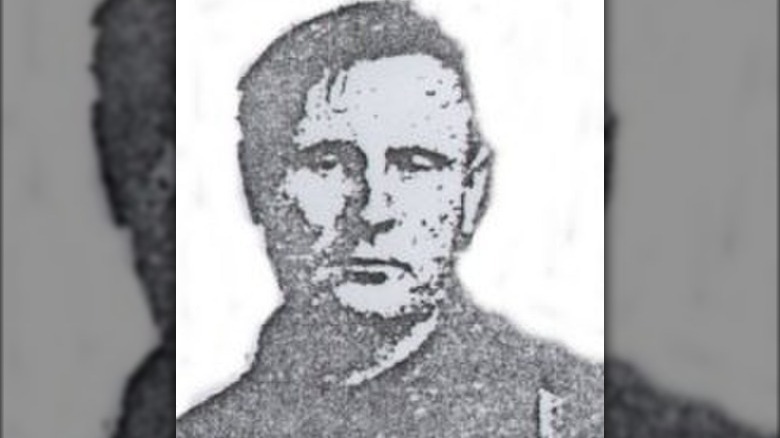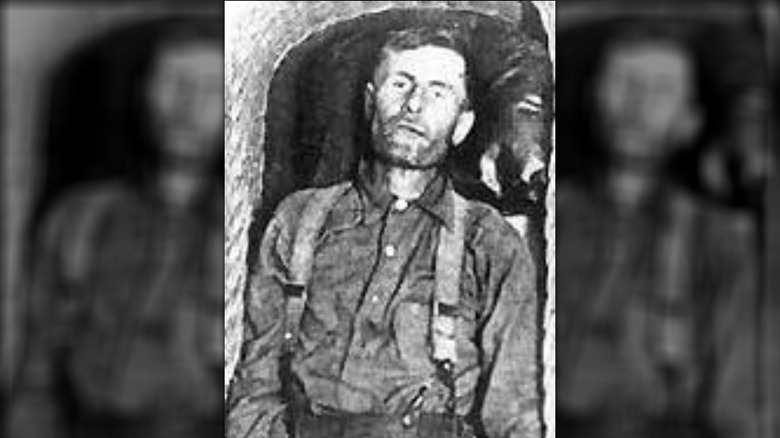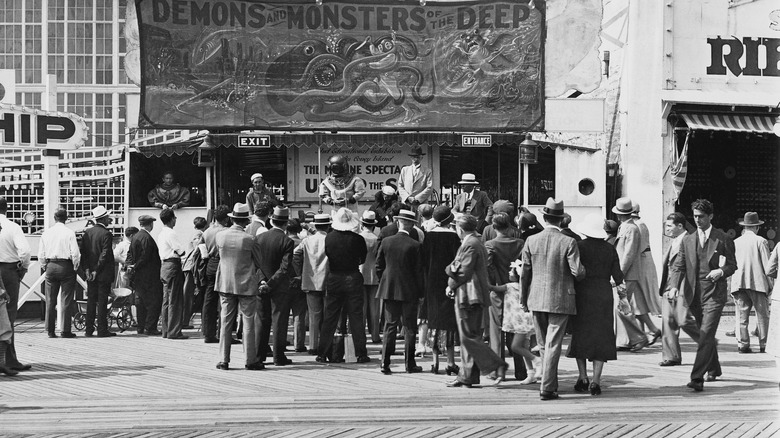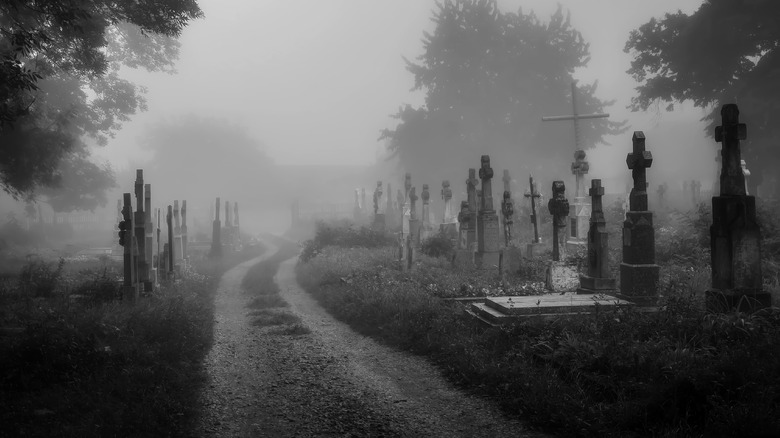The Real-Life Story Behind The Corpse Hidden In A Carnival Fun House
In the mid-1970s, the popular TV show "The Six Million Dollar Man" was in production in California. An emaciated corpse prop was called for. The show's art director found just what he was after: an authentic-looking dead body hanging from a noose in a dusty back corner of a nearby fun house. One of the arms on the brittle dead body prop broke off while it was wrestled down from where it hung. Not a problem, a little mannequin repair was all that was called for and production would be back on schedule, or so the art director on the show must have thought.
But the arm wasn't fake. It was a real human arm, complete with an actual bone sticking out, according to NPR. What the production crew of the "Six Million Dollar Man" TV show had on their hands was a dead body. What's worse, a possible crime scene. Thus begins the truly bizarre real-life story of Elmer McCurdy, a bumbling Old West outlaw who had an amazing second act in Hollywood.
Who was Elmer McCurdy?
The road to Elmer McCurdy's petrified corpse being discovered on a Hollywood film set begins some 90 years prior to his body's recovery. It's a story that seems straight from the golden age of cowboy cinema. McCurdy was born in the 1880s in the eastern U.S. SF Gate reported he came from a well-to-do family but was born to an unwed mother and his father didn't stick around, so growing up, McCurdy was considered "illegitimate."
According to NPR, he had a stint in the army, and worked various odd jobs, including working in lead mines where he contracted tuberculosis. Unable to keep a job due in no small part to his alcoholism, like many people from his time, around the turn of the 20th century, McCurdy went west to find fame and fortune at the tail-end of the frontier.
McCurdy gained experience in explosives and he soon fell in with criminals, according to Ripley. Life as an outlaw was fraught with danger for McCurdy. He wasn't a very good one, and his career was full of bungled heists and mix-ups. McCurdy was an incompetent criminal — NPR reported he once hijacked the wrong train, and another time he tried to blow up a safe in a bank but instead blew up the building while the safe remained intact. By 1911, McCurdy was on the run, and the law was in hot pursuit. After a dramatic gunfight with police, Elmer McCurdy was killed on October 7, 1911. In death, his tale was only beginning.
Elmer McCurdy was embalmed and used as a kind of advertisement
As the William L. Clements Library at the University of Michigan explains, the practice of embalming a corpse, as well as embalming technology, really took off in post-Civil War America as the U.S. population dealt with the devastating wave of mortality caused by the conflict. Even by 1911, when Elmer McCurdy died, embalming was common. And as Ripley's notes, if a dead body was ever left unclaimed at a funeral home, it was sometimes put on display; a grisly and macabre advertisement of sorts for the mortuary services offered within. As the website Earth reported, the funeral industry was banking on people's desires to preserve the way their loved ones looked in life — to prove their skills in the task or art of making a corpse look "life-like," funeral directors would sometimes show off their handy-work.
Having long since fallen in with a disreputable crowd, and with no family to speak of, that's just what happened to McCurdy's bullet-filled corpse, standing for many years in the funeral home with his trusty pistol at his side like a myth of the quickly disappearing Old West. The funeral home where he was left on display even charged for people to view him, and coins could be stuck in his mouth like an arcade game. This was only McCurdy's first stop in his posthumous career in show business (via National Cowboy Museum). McCurdy's dead body was a hit.
McCurdy became a sideshow attraction
Soon enough, word spread that the undertaker in possession of McCurdy's embalmed body had a bonafide moneymaker on his hands. Two grifters shortly came calling, claiming to be McCurdy's brothers, finally arriving to lay their brother to rest, per SF Gate. Believing their story, McCurdy's body was handed over, and it was then transported to California by train. The two men now in possession of this wizened and shriveled dead body weren't really related to McCurdy at all, of course. Instead, they were carnies.
From that point, McCurdy's corpse began a successful career in the circus, drawing crowds all over the country. According to SF Gate, even the Los Angeles Times promoted viewing McCurdy as a fun, family-friendly outing. Also according to Ripley's, the Elmer McCurdy sideshow attraction went by a number of different names — "The Outlaw Who Would Never Be Captured Alive," and the "The Thousand-Year-Old Man" — Carnies have never been known to be particularly truthful. In 1921, the Pomona Progress wrote, of McCurdy, (via SF Gate) "He lived a hard life and died a hard death. Now he is tougher than ever."
McCurdy's next stop was Hollywood
Paralleling the decline of the carnival circuit with the rise of movies, McCurdy's dead body gradually began to draw fewer crowds as a sideshow attraction. Soon, though, the glitz and glamor of Hollywood came calling — if only McCurdy was still around to enjoy it. From the 1930s through the '60s, the rapidly decaying old corpse appeared in several low-budget movies and was even displayed in movie theater lobbies (via Ripley's). In 1933 his corpse, dead for more than 20 years, was used in the film "Narcotic" playing the role of "drug addict" per IMDb.
As time went on, McCurdy was still sometimes loaned out and put on display as an oddity. Soon, McCurdy's dead body was sold off to a number of wax museums, and finally, it ended up in a Long Beach, California fun house, painted bright red. By the 1970s, Elmer McCurdy — failed Old West outlaw and in death, the one-time successful mainstay of freak shows — was largely forgotten to have ever been human — relegated to being a simple prop. The few crowds that still saw his mummified remains had no clue he'd once been alive.
'A severe case of dehydration'
With a mummified corpse on their hands, and with authorities on the scene, the crew of the "Six Million Dollar Man" who initially recovered McCurdy from where he hung joked they might have dealing with a "severe case of dehydration," as Ripley's explains. What an understatement. Clues to the true story of Elmer McCurdy were soon discovered at the Los Angeles County's Coroner's office. According to SF Gate, an autopsy uncovered the period-correct copper jacket of the bullet from when McCurdy was shot, as well as a ticket to a sideshow McCurdy's dead body had once appeared in and a penny from 1924 stuffed in his mouth. The embalming technique was also correct for the time that McCurdy died (via Ripley's).
And with that, the long tragic tale of Elmer McCurdy was pieced together, bolstered by photos of McCurdy while he was alive matched up with what remained of his body. In 1977, the body of Elmer McCurdy was interred back home in Oklahoma, nearby another Wild West outlaw Bill Doolin. With that, the story of a man who traveled west to earn his place in the American mythos was complete.





